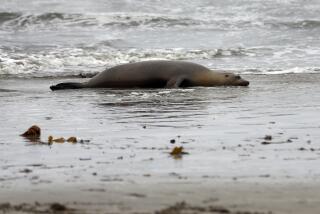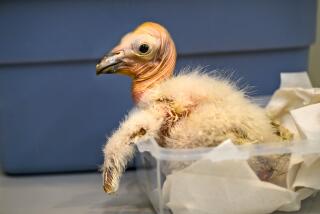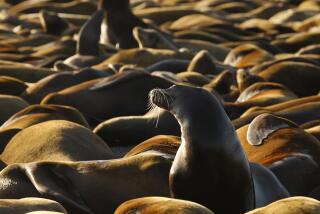California Condor Dies After a Year in the Wild : Preservation: The mysterious death deals a blow to efforts to save the species. Biologists are puzzled because the bird had seemed healthy.
- Share via
VENTURA — One of the first two California condors to be released in the wild has died, dealing a setback to biologists trying to bring the species back from extinction.
The death of 15-month-old Chocuyens (pronounced cho-KOO-yenz) has left 17-month-old Xewe (GAY-wee) to fly alone and has saddened and mystified biologists who recovered the carcass Thursday from a rocky ledge near Pyramid Lake Dam.
An examination at the San Diego Zoo found that Chocuyens appeared healthy and showed no signs of injury, but tissue samples have been sent to the Patuxent Wildlife Research Center in Laurel, Md., for toxicology testing.
“If it was a healthy bird and died that abruptly, you’d expect to find some physical evidence,” said Robert Mesta, condor program coordinator for the U.S. Fish and Wildlife Service.
“The X-rays didn’t reveal any broken bones, there was no brain damage like it had suffered a concussion,” Mesta said. “I was told it looked like a very healthy bird.”
Chocuyens’ death has forced the condor biologists to change their strategy for releasing more of the young birds in December. Biologists began a breeding program at San Diego Wild Animal Park and Los Angeles Zoo in 1987 in an effort bolster the number of condors in the wild after the population had dwindled to 27.
Last week, they had trapped No. 38 and No. 39, two Andean condors that had been released with Chocuyens and Xewe to act as mentors in the wild. Chocuyens and Xewe were to have taken the Andean condors’ place as elder guides for six more 6-month-old California condors that were scheduled to be released in December.
Now, the biologists must re-release No. 38 and No. 39 to keep Xewe company until the other California condors arrive, Mesta said.
“Having a single Californian out there makes us nervous,” he said. “They’re not a solitary species; they’re very gregarious.”
The news of Chocuyens’ death hit hard.
“I didn’t cry last night till I was alone,” biologist David Clendenen said. “You spend so much of your life working with them and trying to keep them healthy, and something like this happens, it’s devastating.”
Clendenen had helped trap AC-9, the last-known wild condor, in 1987, and added it to a breeding program at San Diego Wild Animal Park that has increased the number of captive California condors from 27 to more than 50.
And he had ushered AC-9’s daughter, Xewe, and Chocuyens, whose parents were captive condors, from the hands of their caretakers in October, 1991, to a lofty site in the Sespe Wilderness in Ventura County. The two California condors were released there in January.
“I talked to an old friend who was a veterinarian on the project and moved to Melbourne,” Clendenen said Friday. “I talked to her on the phone and I broke down at that point. We cried together.”
On Thursday, he helped retrieve the carcass of the giant bird, which had grown to 20 pounds and had a wingspan of more than eight feet.
Biologists had monitored the only two wild California condors daily. They had fitted the birds with radio transmitters on both wings. One radio was battery-powered and the other was a solar-powered backup, Mesta said.
Chocuyens’ signal showed that he had not moved since Tuesday.
Late Wednesday afternoon, field biologist Dan Peterson saw him through a high-powered scope about 1,500 feet away, face down on a ledge where the two condors habitually roosted, Clendenen said.
At dawn Thursday, the biologists strapped on cameras, slung ropes over their shoulders and picked their way across the 400-foot-high cliff face to the roost.
They found no clues to his death, Clendenen said.
They slipped the carcass into a nylon sack, hauled it back to the cliff top, packed it in ice and drove it to the San Diego Zoo.
Zoo pathologist Marilyn Anderson spent three hours on a “cosmetic necropsy,” examining the carcass but leaving it pristine enough to preserve and mount for later study, zoo spokesman Jeff Jouett said.
Jouett said that Anderson found none of the lead shotgun pellets that have poisoned condors in the past, no intestinal blockages that could have starved Chocuyens--no bit of evidence on which to hang a theory.
“I think that we expected birds to die through the whole thing,” Clendenen said. “It’s hard to take when it happens, but it’s just part of the game. We’re going to keep marching on and hopefully, if we can find out what killed the bird, we can negate that in the future.”
Results from the Maryland toxicology tests should arrive in a few days, Mesta said.
“We’re just really perplexed at this point,” Mesta said. “It was a shock, it really was. We didn’t expect it and we’re really anxious to find out what happened.”
More to Read
Sign up for Essential California
The most important California stories and recommendations in your inbox every morning.
You may occasionally receive promotional content from the Los Angeles Times.










